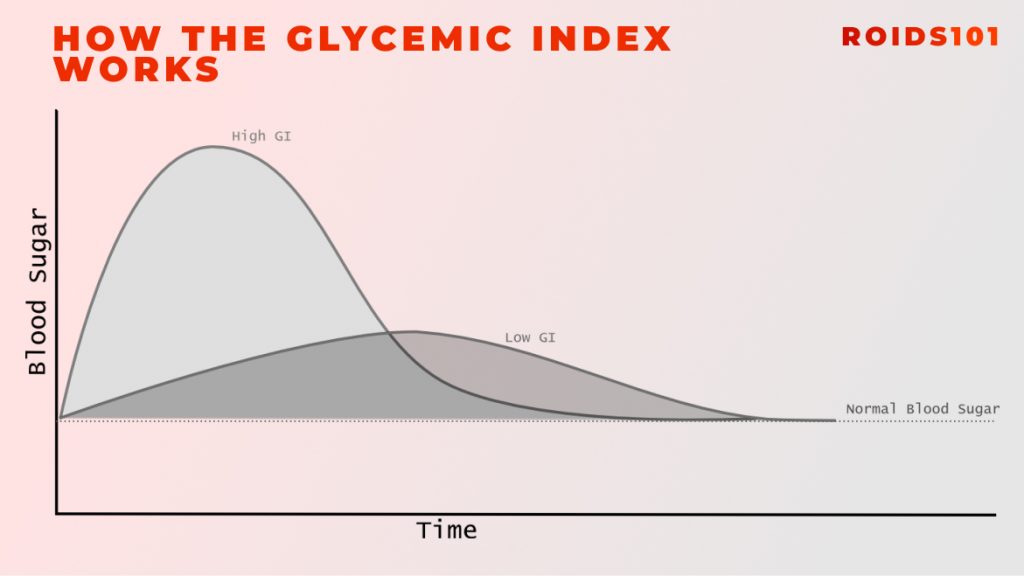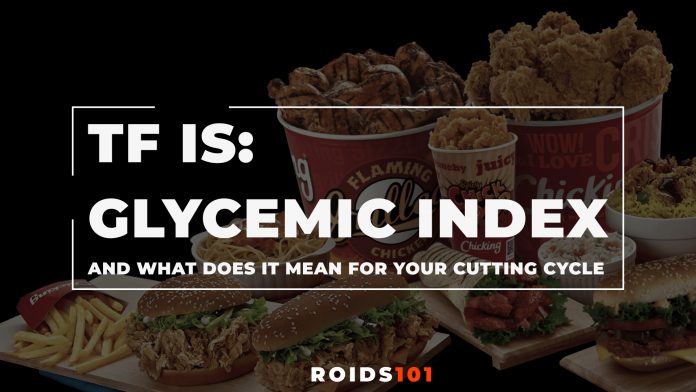Diet is just as important for your weight loss as Arnold is for Terminator 2 or Tom Cruise for Top Gun. And all food in your diet has that one crucial aspect: the glycemic index. So what is glycemic index? And what foods do you need on a cut?
Here’s all you need to know about the thing. Keep in mind that no amount of Clenbuterol and no hardcore doses of Anavar will help you lose fat if you don’t get your diet on point. And the glycemic index is at the very core of it.
The Basics: What is Glycemic Index?
It’s all about how different foods affect our blood sugar levels, and it’s a real game-changer when it comes to understanding nutrition.
By the book:
The glycemic index measures the rate at which carbohydrates in food are broken down and released as glucose into the bloodstream.
Think of it as a speedometer for your carbs:
When you chow down on a high-glycemic index food, like a slice of white bread or some sugary cereal, it quickly gets converted into glucose and spikes your blood sugar levels. But here’s the thing: those blood sugar spikes can leave you crashing and feeling hungry soon after.
Now, on the flip side, low-glycemic index foods, like veggies, whole grains, and other “boring” things you hated in your childhood break down more slowly. This means your blood sugar rises more gradually, giving you a steady and sustained release of energy. No rollercoaster rides.
Why is it Important
Understanding the glycemic index is key for athletes, weight management, and overall health. It helps you make informed choices about the carbs you consume.
If you want to keep your energy levels steady, avoid those crazy crashes, and optimize your performance, pay attention to the glycemic index: it’s a tool that can make or break your performance and the success of your cut.
When you’re on, say, Trenbolone, in the middle of an off-season bulk, it doesn’t play a big role. However, when you’re cycling dry cutting gear — like Winstrol, or Anavar, or just low doses of Test E, it IS important.
What is the difference between blood sugar and glycemic index?
Blood sugar, or blood glucose, refers to the concentration of glucose in our bloodstream at any given time. It’s affected by various factors, including the foods we eat.
On the other hand, the glycemic index is a measurement of how different carbohydrates in food affect our blood sugar levels. It’s like a ranking system, showing you which foods cause a quick spike or a slow and steady release of glucose.
What are low glycemic foods?
Now — to practice.
Low glycemic index foods typically have a GI of 55 or less. Think of stuff like non-starchy vegetables, whole grains, legumes, and nuts. The full list is enormous, but here are the things that you’re most likely to find in your daily routine.
Here’s a long list of foods that are typically considered to have a high glycemic index (GI):
- White bread;
- Bagels;
- Corn flakes;
- Instant rice (yeah, takeaways count too);
- Short-grain white rice;
- White potatoes;
- Watermelons;
- Pineapples;
- Noodles;
- Popcorn;
- Raisins;
- Honey;
- Corn syrup;
- Coke, Pepsi, Sprite, whatever sugary drink it is;
- Sugary breakfast cereals;
- Mashed potatoes;
- White flour products (like cakes, cookies, and all sorts of pastries);
- Pasta;
- Ice cream;
And so on. You get the point.
High GI Foods
These are the ones you’ll see on every single “Healthy Food” picture in Pinterest or in any fitness cookbook:
Non-starchy vegetables:
- Broccoli;
- Spinach;
- Kale;
- Bell peppers;
- Cauliflower;
- Zucchini;
- Asparagus.
Legumes:
- Lentils;
- Chickpeas;
- Black beans;
- Pinto beans;
- Any type of beans (you name it, they’re all low-GI).
Whole grains:
- Oats;
- Quinoa;
- Bulgur;
- Brown rice.
Nuts and seeds:
- Almonds;
- Walnuts;
- Chia seeds (good stuff, though the whole “superfood” buzz overhyped them);
- Flaxseeds;
- Pumpkin seeds.
Your favourite lean proteins:
- Chicken breast;
- Turkey breast;
- Fatty fish;
- Tofu;
- Tempeh.
And also:
- Sweet potatoes;
- Greek yogurt (unsweetened);
- Cottage cheese;
- Eggs.
Bet you’re not surprised with a single position here, but it’s still a nice reminder that you can use.
10 High-GI Foods You Should Avoid on a Cutting Cycle
If you don’t really want to worry a lot, you can just ditch some foods completely.
When it comes to managing your calories on a cutting cycle, there are some foods that are generally recommended to be avoided or consumed in moderation.
Here are 10 examples:
- Sugary beverages: Like Coke and sweetened juices, they can cause quick spikes in blood sugar;
- White bread and refined grains: Those are often stripped of fiber and nutrients, leading to faster digestion and higher GI;
- Sugary cereals: Don’t let Nestle propaganda and the shit-colored rabbit trick you. They are often loaded with added sugars, causing blood sugar roller coasters, and providing not much benefits at all;
- Processed snacks: Things like chips, cookies, and candies are usually high in refined carbs and unhealthy fats;
- Sweetened yogurt: Some yogurts have added sugars, so it’s good to check the labels and opt for plain or unsweetened varieties. Classic greek yogurt is a much better alternative;
- Fruit juices: Even though they may seem healthy, they can have concentrated sugars without the beneficial fiber of whole fruits. Yeah, a glass of an orange fresh for breakfast is just a marketing thing;
- Fried foods: High-fat fried foods can contribute to weight gain and insulin resistance;
- Alcohol: Duh. It can affect blood sugar, it’s inefficient in every aspect, and basically doesn’t work well with anabolics;
- High-fat dairy products: These can be high in saturated fats, which can impact heart health;
- Processed meats: They often contain unhealthy additives and can be high in sodium, which may have negative health effects.
Fruits on a Cutting Cycle
Sadly, there are just a few fruits that are relatively low in sugar content and have a low enough glycemic index. Here are a few examples:
- Berries: Strawberries, raspberries, and blackberries are all low in sugar and high in fiber and antioxidants;
- Avocado: While technically a fruit, avocados are low in sugar and high in healthy fats;
- Lemons and limes: These citrus fruits are low in sugar and can add a burst of flavor to your dishes or beverages;
- Tomatoes: Versatile and can be used in various recipes. Yeah, it’s a fruit.
Remember, fruits contain natural sugars, but they also offer important nutrients: it’s not just about glycemic index in this case.

Glycemic Index When Steroids Come Into Play
When it comes to building muscle with gear and optimizing performance on your cycle, carbohydrates play a vital role as they provide energy for intense workouts and aid in muscle recovery.
High glycemic index (GI) foods are known to raise blood sugar levels quickly, and some argue that consuming them post-workout can help replenish glycogen stores rapidly and promote muscle growth.
On the other hand, low glycemic index foods break down more slowly, and opting for these foods can provide a potentially better fat utilization during exercise.
So, what do you do? Simple stuff:
- High GI foods (that are not trash food or fast food) go right after the workout;
- Low GI foods belong in your breakfast;
- And generally, on a cut, low GI foods should be prioritized, as they just keep you feeling full for a longer period. A vital thing to consider when you’re on a calorie deficit.
Most bodybuilders go for a combination of both high and low glycemic index foods to cater to different needs. Proper nutrition is key, and finding the right balance for your body and goals is crucial.



